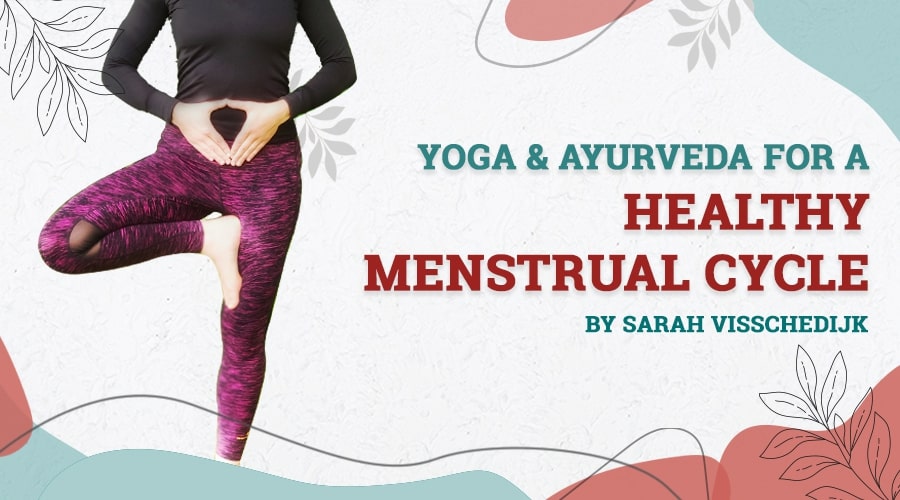Hormonal Health: Yoga for a Healthy Menstrual Cycle
Throughout history, menstruation has been seen both as impure and sacred in different cultures around the world. In cultures where the period was seen as sacred, there was a lot of knowledge about how to balance the menstrual cycle with the help of herbs, yoga, and diet.
Only recently menstruation has become something to be completely ignored by both men, women, and the whole culture around it. A lot of women today view their menstruation at best as an inconvenience or disruption in their schedule, and at worst as a curse. In many cases, when women experience menstrual complaints like pain or PMS, this is partly caused by the way they view menstruation. Most of us have been taught it’s an annoyance you just have to live with, and for some of us, it was even something to be ashamed of.
These beliefs are rooted deeply within our system and can eventually even cause physical problems. Especially when we try to completely ignore the fact that we have a menstrual cycle. We try to live a linear 9 to 5 life, based on patriarchal beliefs, and have totally forgotten the value of our feminine, cyclical nature and wisdom.
Right now, the earth is suffering under a patriarchal system that values logic over intuition, scientific evidence over our body’s innate wisdom, and a linear scheduled life over spontaneity, creativity, and flow. And it’s not only women that are oppressed by this system, it’s men as well. There is an epidemic of stress, anxiety, overwhelm, chronic fatigue, depression, and all kinds of diseases. In order to change this we need to embrace the vital power and lifeforce of the feminine. We need to get out of our heads and connect back to our bodies and to mother earth. For women, this starts by embracing the menstrual cycle and learning how to utilize yoga, diet, and lifestyle changes to support their hormonal health.
Improving Hormonal Health by Embracing the Menstrual Cycle
The first thing we can learn from our menstrual cycle is that we are cyclical beings. This is not only true on a physical level, but also on an energetic and emotional level. In our society this cycle is completely ignored. Our whole system is linear based, ignoring our innate need for rest and inner reflection that we need to take actions that are guided by our hearts. This is the reason why many of us feel overwhelmed, unfulfilled, and stressed out.
We are trapped in a system that does not support our female health and puts our whole hormonal system at risk. Our linear based life is the reason we are stuck in survival mode instead of thriving. Although we might not be able to change the whole system at once, we can start by living according to our own nature and taking simple steps to actually listen to our body’s needs and adjusting our yoga practice accordingly.
A feminine approach to yoga
Although the Yoga community today is mostly dominated by women, there once was a time it was meant exclusively for men. It was essentially designed for a male body. Besides that, we also currently live in a society that is in masculine overdrive, causing many women to practice Yoga in a more masculine way. However, women have a different body and different needs. One major difference is that women go through way more hormonal fluctuations each month which directly impacts their energy, mood, and physical body.
A feminine approach to yoga honors this monthly cycle. It’s all about working with your body and listening to it, instead of going against it. Only when you really listen to your body’s needs, you can achieve optimum health and vitality.
An important ancient Yogic principle is ahimsa, which means non-harming or non-violence. Although we all have learned not to harm others, many of us have forgotten to actually be gentle with themselves. Especially women can be very hard on themselves and push themselves into more ‘yang’-like exercises and rigorous yoga sequences, without balancing it through restorative practices such as Yoga Nidra and Yin Yoga.
Hormonal health issues among women have severely increased over the last decades. Menstrual cramps, PMS, and even deeper conditions such as endometriosis and PCOS are rising, as well as infertility and menopausal symptoms.[1]
The first step to a more feminine approach to yoga and female health is to acknowledge and embrace our cyclical changes throughout the month, and also the changes during the year and in our lives.
Yoga and Ayurveda for a Healthy Menstrual Cycle
Yoga can play an important role in balancing hormones. Therefore, yoga can be utilized to balance and support the natural menstrual cycle of a woman. Each asana has a different effect on the body and therefore on the hormones. It’s especially useful in balancing our stress and sex hormones. Chronic stress can have a huge impact on a woman’s reproductive health. This is because our body always prioritizes survival over reproduction[2]. Yoga can help to calm down the nervous system and therefore the stress response in the body, which is important to keep the balance between the sex and stress hormones.
Which Yoga practice will be beneficial can be different for each person, depending on their natural body-mind constitution but more importantly their current state and imbalances. This is where Ayurveda can help us.
What Ayurveda teaches us about women’s health
Yoga and Ayurveda are sister sciences. Ayurveda literally means the science of life.
According to Ayurveda, menstruation is a natural cleansing process that shouldn’t be painful or uncomfortable. Menstrual cramps may be common, but they are not normal. Ayurveda says menstruation reflects the condition of a woman’s overall health. Birth control or other forms of synthetic hormones mask her true condition.
When something is wrong with your menstrual cycle it’s usually an indication of a larger health issue. A wrong diet, lifestyle, genetic causes, and stress can be underlying factors. The menstrual cycle, such as its regularity, blood quality, duration, and other symptoms such as cramps, heavy periods, or absent periods, can tell you a lot about your current imbalances. In this way, your menstrual cycle, is like a barometer for your overall health.
Ayurveda teaches us that we all have a unique body-mind constitution, which is why we all have different needs.
According to Ayurveda everything in the universe, living or nonliving, consists of 5 elements: Ether, Air, Fire, Water, and Earth. These 5 elements form three basic body-mind types or doshas:
- Vata (ether + air),
- Pitta (Fire + Water), and
- Kapha (Water + Earth).
Vata is responsible for all movement in the body and mind. Pitta is responsible for all transformations in the body and mind. Kapha is responsible for structure and stability in the body and mind.
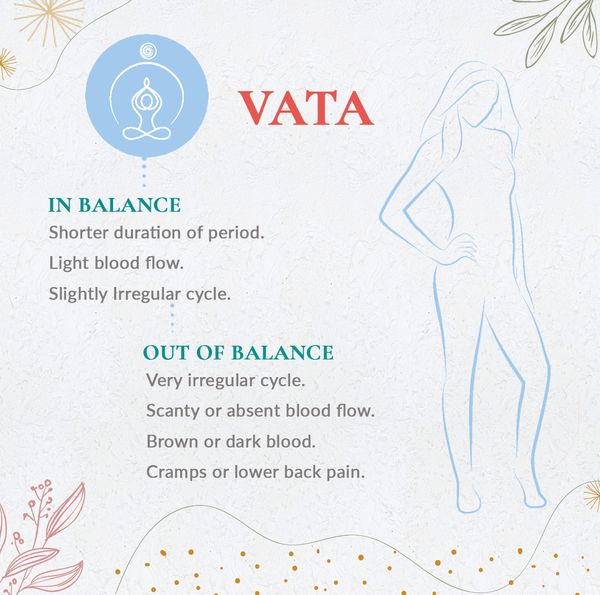
1. Vata
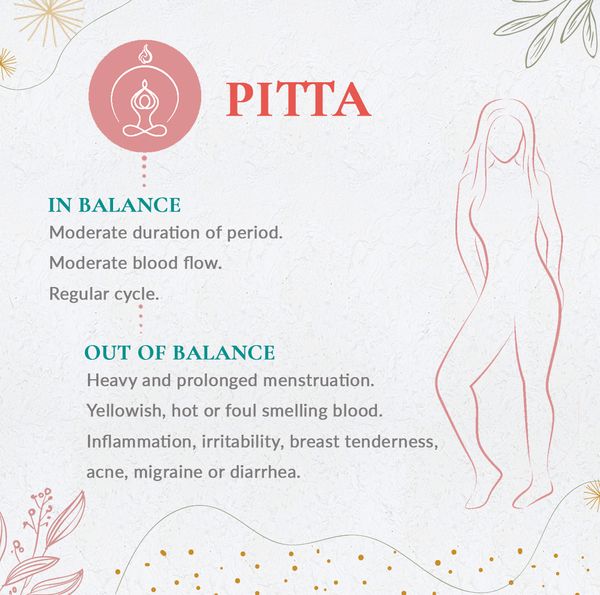
2. Pitta
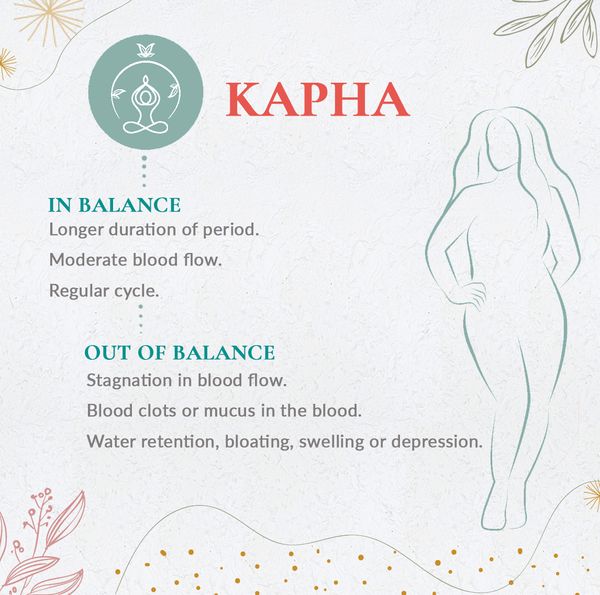
3. Kapha
We all consist of all the three doshas, otherwise, we wouldn’t be able to function. However most of the time 1 or 2 of these doshas are predominant. Your unique composition of these three doshas determines your physical and mental characteristics. By learning about the doshas you’ll learn a lot about yourself. These doshas can also go out of balance. Ayurveda can help you to understand your body’s signals and needs.
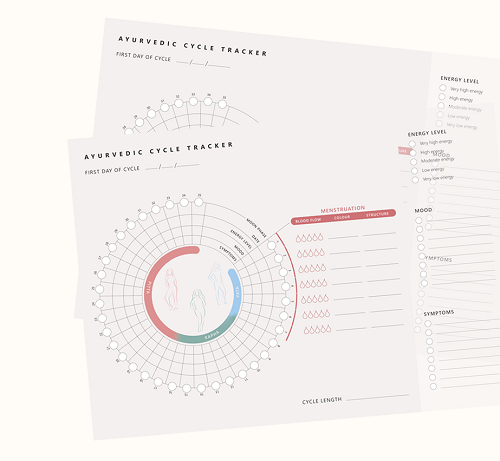
Improve your menstrual cycle with the help of yoga & Ayurveda
Get your free Ayurvedic Cycle Tracker directly into your inbox
The Menstrual Cycle: Yoga Practices for Each Phase of the Cycle
Each month a woman goes through different phases. According to Ayurveda each of these phases is predominated by one of the doshas. This affects the way you feel and what yoga practice is most beneficial to support the internal changes of that particular phase. When teaching yoga for a healthy menstrual cycle, it is important to be aware of the three physical, hormonal and emotional phases every woman goes through each month:
The menstrual phase
The menstrual phase is predominated by the Vata dosha. Vata is responsible for all movements in the body. Apana Vayu, one of the subdoshas, is responsible for all downward and outward movements, such as urination, defecation, and smooth menstruation. When Vata is out of balance this can disturb the downward flow of Apana Vayu and can, therefore, cause all kinds of menstrual disorders such as cramps or scanty periods.
The most important thing during this phase is to balance Vata. That means the yoga sequence should by grounding, relaxing, gentle, and nurturing.
The follicular phase
The follicular phase is like spring. Once the menstrual blood has shed, estrogen rises and the body starts to build a new endometrium lining in the uterus, and new follicles start to grow in the ovaries. According to Ayurveda it’s the Kapha phase of the cycle, as estrogen is a more Kapha-like hormone and builds new tissues.
It’s a more dynamic phase and a great time to start new projects. Emotionally and mentally your energy starts to increase, however, it’s important to take the time to rebuild your energy instead of jumping right into high gear.
Dynamic Vinyasa Flow sequences, as well as active Hatha Yoga practices with standing poses, arm balances, active inversions, and backbends will help to stimulate the body and mind to feel more energized and strong. All these poses balance Kapha and prevent you from feeling sluggish or lethargic.
As estrogen rises its peak, ovulation happens, and you’ll feel most fertile, juicy, and feminine.
The luteal phase
After ovulation, estrogen levels drop, and we go into the luteal phase. According to Ayurveda this phase is predominated by the pitta dosha, due to the rise in progesterone, which is a more Pitta-like hormone. It maintains the uterine lining and engorges it with blood vessels to prepare for possible conception.
This is often considered the most challenging phase. When there is too much heat in the body, this can cause more classical PMS symptoms such as irritability, headache, agitation and acne on the face.
Although it’s a less accepted phase in our society, it’s actually a great time for healing, since women are more attuned to their intuition and messages from the subconscious become more accessible. Emotions from your subconscious rise to the surface to be felt and healed. Meditation, journaling, daydreaming and long walks in nature are great during this time.
The main intention of your yoga practice during this time should be to calm down the nervous system with more Yin-like practices, cool the mind, restore energy, nurture the body, and support the natural detoxification process of the body.
Balancing the menstrual cycle with yoga
Although not everyone has menstrual problems, there is a significant group of women today that experience all kinds of imbalances and disorders, such as painful periods, heavy bleeding, PMS, endometriosis, PCOS, or uterine fibroids. Diet, lifestyle, and yoga can help rebalance the system and reduce symptoms. Regulating your menstrual cycle will also optimize your fertility and chance for conception.
The next transition in a woman’s life, menopause, should also be going smooth and without problems when a woman is healthy. The process of menopause already starts at age 35 when progesterone starts to decline[3]. A balanced lifestyle, eating the right foods, reducing stress, and doing the right exercises will help you go through menopause smoothly. Furthermore, take menstrual difficulties or disorders seriously as they reflect your overall health. When balanced on time, it will prevent bigger problems during menopause. The best time to start with that is today.
Promote a healthy blood flow to the pelvic area
A healthy blood flow to the pelvic area keeps the reproductive organs, such as the uterus,ovaries and fallopian tubes, healthy. Tight muscles around the pelvis or the wrong pelvicalignment can decrease this blood flow and cause restriction in the pelvic area. This couldinfluence menstrual difficulties.Include asanas in your yoga practice that stretch the hips and thighs and increase pelviccirculation, such as bound angle pose (baddha konasana), Seated wide angle pose(upavistha konasana), yogi squat (malasana), half moon pose (ardha chandrasana), pigeonpose (Eka Pada Rajakapotasana) and hip circles.This will promote a healthy blood flow to the pelvic area, which can possibly ease menstrualpain.
1. Yogi Squat - Malasana
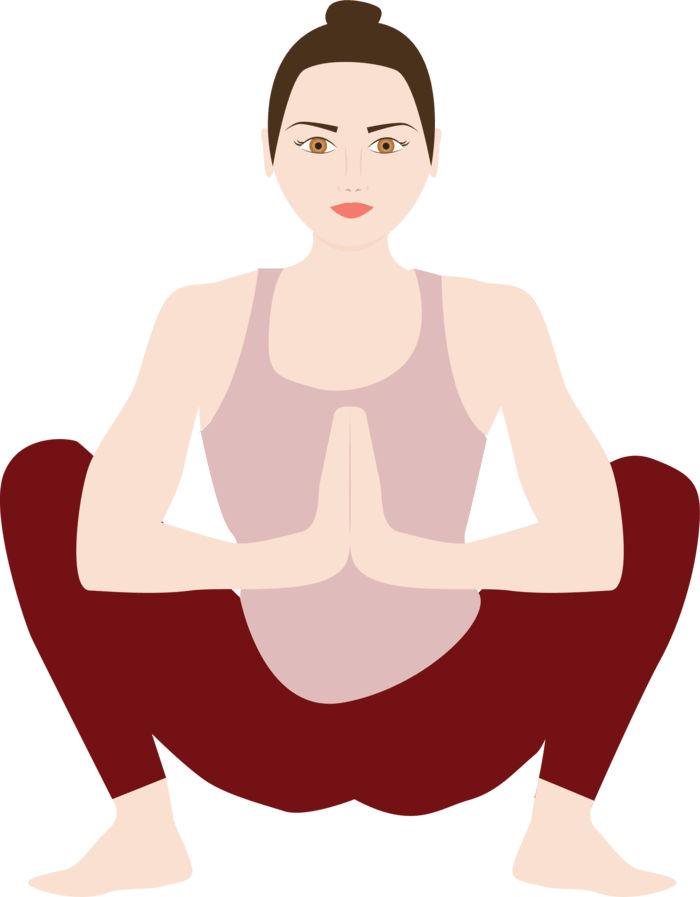
Yogi Squat - Malasana
Malasana is a great pose to balance all the doshas, especially de vata and pitta dosha. Itespecially helps to balance the downward moving energy called apana vayu.
Other benefits include:
- It promotes blood flow to the pelvic area, by stretching the pelvic floor muscles
- Mobilizes the hip joints
- Supports healthy elimination
- Supports healthy menstrual flow
It’s a great pose during menstruation as it supports the downward flow of apana vayu. This is only beneficial when you can relax into the pose and relax your abdomen.
2. Pigeon - Eka Pada Rajakapotasana
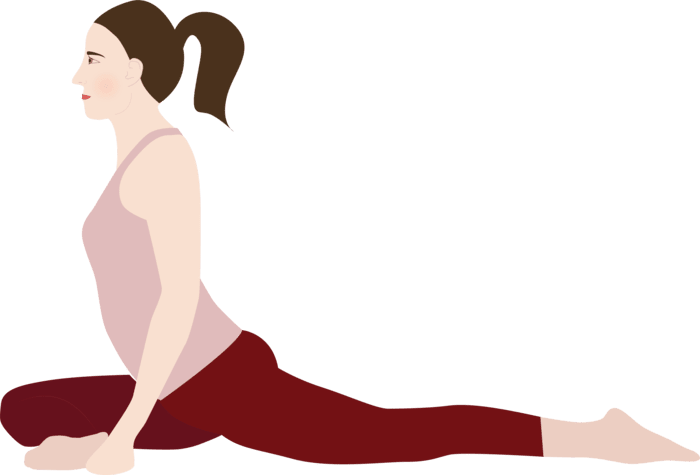
Pigeon - Eka Pada Rajakapotasana
The pigeon pose helps to balance the vata and pitta dosha. It helps to open the hips andespecially stretches the piriformis muscles and gently stretches the psoas muscle. So, it promotes a healthy blood circulation to the pelvic area.
For a more restorative version you can use a bolster. This way you can stay longer in thepose, enhancing its therapeutic benefits and increasing the calming and nourishing effect onthe nervous system.
3. Half moon - Ardha Chandrasana
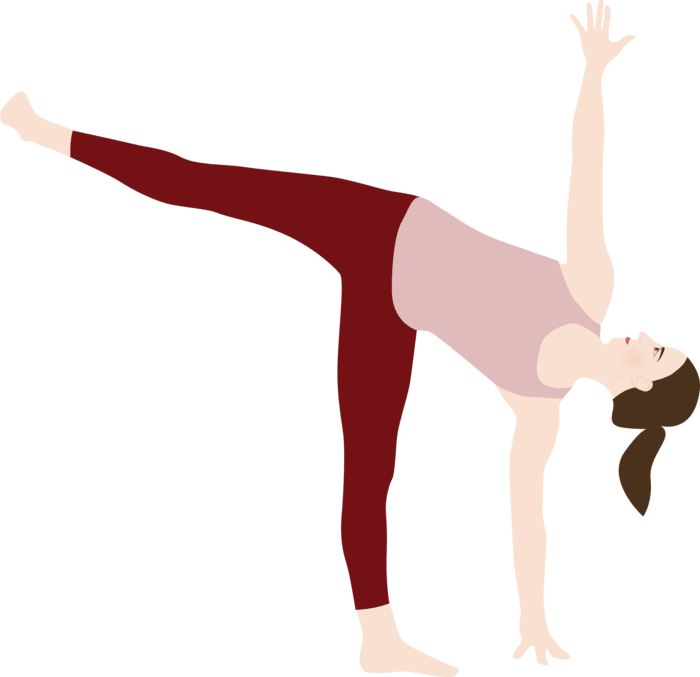
Half moon - Ardha Chandrasana
The half moon pose balances all doshas, especially kapha dosha as it strengthens the legsand opens the chest.
Benefits:
- Increases circulation in pelvic area and reproductive organs.
- Creates mobility in the hip joints
- Opens the chest
- Promotes balance
During menstruation this pose can be done with support of the wall as it can help to alleviatemenstrual cramps for some women.
4. Seated wide angle pose - Upavistha Konasana
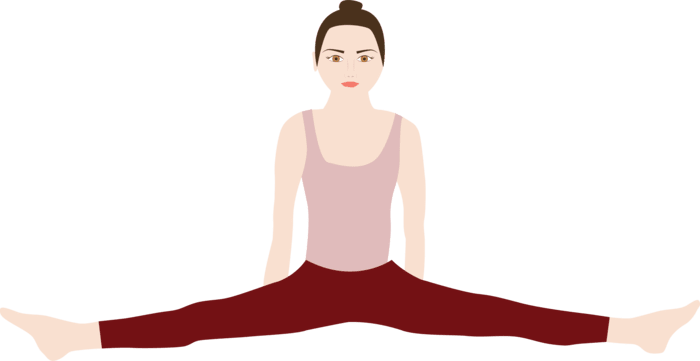
Seated wide angle pose - Upavistha Konasana
Balances vata and pitta dosha.
Benefits:
- Improves circulation to hip joints and pelvic area
- Relaxes and gently stretches the pelvic floor
- Calms the nervous system
- Can help to relieve menstrual cramps as it relaxes the abdominal area
5. Bound angle Pose - Baddha Konasana
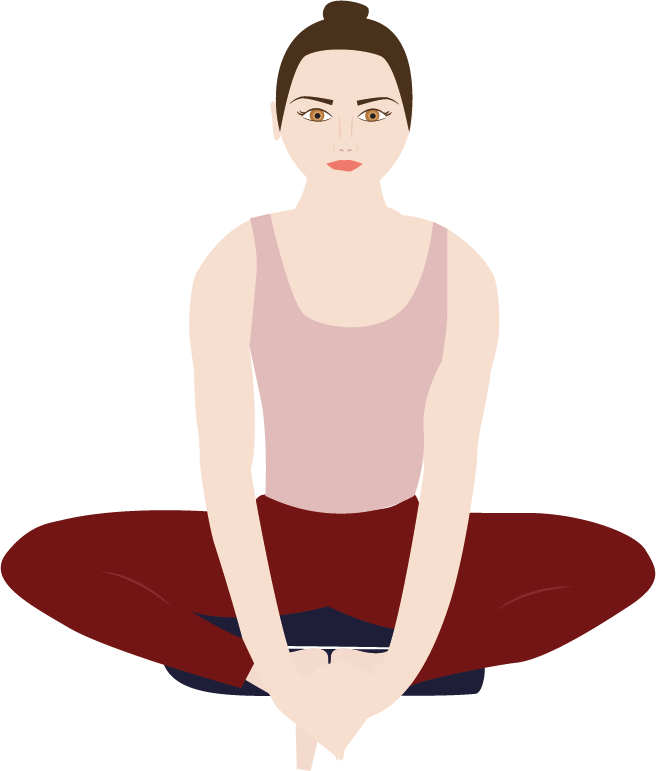
Bound angle Pose - Baddha Konasana
This pose balances all doshas.
Benefits include:
- Relieves stiffness in the joints and hips
- Releases inner thighs and groins
- Tones the pelvic floor, bladder and uterus
- Promotes apana vayu
Conclusion
Together, Yoga and Ayurveda support women’s hormonal balance throughout the monthly cycle. This is not only important to have smooth periods, but it’s important for women’s overall health and fertility. An important principle is to follow the natural flow of a woman’s cycle, which includes both energetic, outgoing, productive phases as well as periods of reflection, rest, and rejuvenation.
As a health professional, whether you’re a yoga teacher or (ayurvedic) therapist, it’s important to guide your students or clients towards optimal health. To support women’s health, it’s important to understand their true nature. By understanding Ayurvedic principles you can guide women towards a more balanced and fulfilled life, using Yoga and Ayurvedic lifestyle practices.
Resources
[1] - The book Balance Your Hormones, Balance Your Life by Dr. Claudia Welch provides different examples and resources that indicate an increase of menstrual disorders, infertility and menopausal imbalances over the last decades.
[2] - Dr. Claudia Welch, Balance Your Hormones, Balance Your Life, p. 30/31
[3] - Dr. Claudia Welch, Balance Your Hormones, Balance Your Life, p. 115/116
Bobby Clennell, The Women's Yoga Book
Ana Davis, Moving With The Moon
Robert Svoboda, Ayurveda for Women

Improve your menstrual cycle with the help of yoga & Ayurveda
Get your free Ayurvedic Cycle Tracker directly into your inbox

